Taste of Sweden couldn't be sweeter
Swedish treats at the Viking Center during the Midsommer Festival were delicious, but not as memorable as the event which attended them at our table. In conversation with a lady from Aurora at our table to the right, she mentioned that as a young woman she had attended her church school in Chicago. Before I could ask, she volunteered that that school was North Park, the Covenant college. Both of us were surprised since we shared that experience!

It was only the beginning, however, since she went on to explain that her grandfather was a Covenant minister from Nebraska. Again I was primed with a question but she beat me to the answer: it was Rev. Oscar Palmberg who served churches including Stromsburg, Belvidere, Mamre and others. There has long existed a family rumor that the Rodines were somehow connected with the Palmbergs. That has been confirmed in the knowledge that Rev. Oscar's wife died when some of their large family was still small, and her dear friend Augusta Rodine became his second wife. Carolyn confirmed all this and we both marveled at this chance meeting of distant relatives.
There was still more to come. When Judy Beatty to our left remarked that she was related to the Rodenes it was time to make another connection. Though we have known each other for years, it now can be told that Tom Rodene's mother is related to Judy and Tom to me, though the spelling of the last name, Rodene, varies among family members.
It was one of those amazing Stromsburg moments. People sitting down to eat some Swedish food, and finding out they are all related!
-Dalakarl
..................................
Where Do I Fit In?
It is the title of a book by Linoma Wingate and the theme of her presentation at the Stromsburg Library during the Swedish Midsommer Festival. Learning that she was from the Holdrege area and that the book was written to make sure her grandchildren knew the richness of their family's immigration to America, prompted us to give top priority to that program.
Not far into the presentation Linoma mentioned her family roots in the area of Overton. Since that is where Eleanor grew up, our interest level went even higher. They even shared the surname, "Johnson," but so did many others then and now. Her great uncle Charlie One-eye Johnson had one of those identifying nicknames communities came up with to tell one Johnson from another (my great uncle was known as "Sunday School Joe Johnson").
Eleanor remembers stories about "Charlie One-eye" being told in her family. There are some choice ones in this book and a picture of his bachelor cabin near the Platte which was still standing. The story goes all the way from Sweden to Phelps county; from the first one to venture across to the later members of the family...all but two siblings whose descendants were later visited in Sweden by members of the American branch, including the author.
Far from idyllic, Linoma describes the family as a tapestry: much beauty on the surface but some ugly knots on the underside. Readers of the book will gain full appreciation of the meaning of this imagery. From poverty to prosperity, from failures to successes, this is one great story. On the maps provided in the book we even spotted the farm of J.P. Nelson, Eleanor's home. Yes, even we "fit in." The author generously provided a copy of the book to our Library.
-Dalakarl
...................................
J.W. Stromberg of Orleans
At the Midsommer Festival authors Kathy Nelson and Chuck Leypoldt shared a table in the square selling theier respective books. Chuck also brought me a copy of the Orleans, Nebraska, centennial book of 1972. This would be of particular interest since there was a Swedish colony there and a Mission church from the very early days. There was also a remarkable pioneer pastor by the name of J.W. Stromberg.
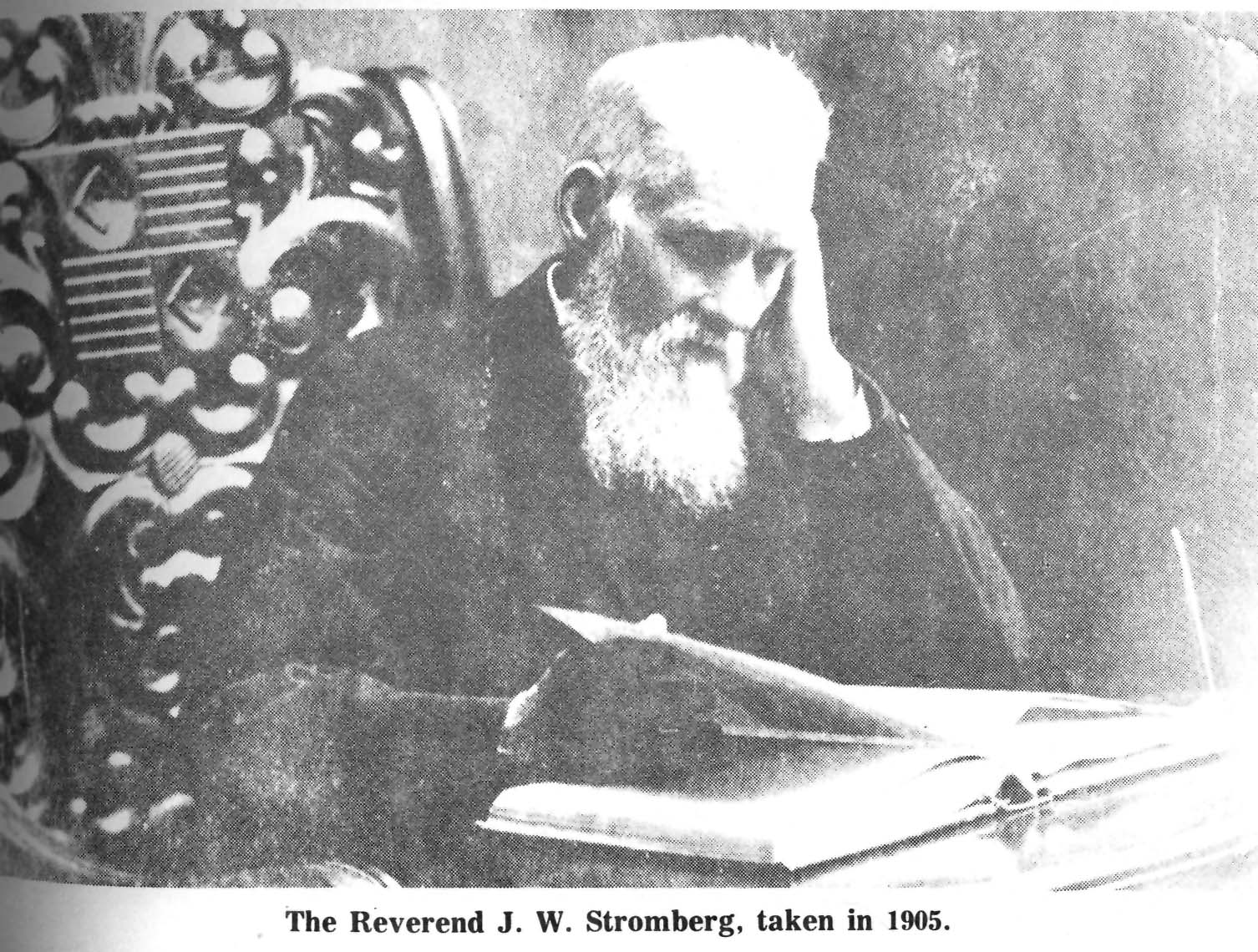
Rev. Stromberg's story is in some ways similar to that of Rev. Princell of the Free Mission school, Rev. A.N. Sweders and Rev. C.A. Falk, both of Stromsburg, in that they began as ministers of the Augustana Lutheran church and ended up as Free Mission pastors. Aside from Sweders, each also belonged to a briefly existing group called the Ansgar Synod centered around Galesburg and Knoxville, Illinois.
According to the account of the Stromberg family in the Orleans centennial book, Rev. Stromberg came to Illinois after serving Augustana churches in Warren, Pennsylvania, and Jamestown, New York. He then became a pioneer farmer in Harlan county Nebraska, founding a Swedish Mission church there. His horizons stretched far beyond Harlan county, however, since he reportedly conducted meetings as far away as Boston and was part of an Ansgar committee to investigate merger with the Mission Synod before the former synod dissolved in 1884-85. For this he is mentioned in Nyvall's history of the Covenant.
Like Falk and Sweders, Stromberg owned his own farm and his family engaged in business locally for years to come. This arrangement worked out for independant-minded ministers who could support themselves without denominational help. Each also was free to cooperate with the Nebraska Conference of the Covenant church as well. In more recent times the Stamford church joined the Evangelical Free denomination.
-Dalakarl
...................................
Now: Historical Stromsburg
The Facebook group "Destination Stromsburg" ranks right up there with viewing grandkids' pictures for me. Polk County Historical Society Chairman Charles Noyd has been adding pictures from the old days to that site from the outset, but now he has launched a new site dedicated just to that subject, "Historic Stromsburg."
A recent post was a picture of the John Colson house which, according to best recollection, was the one northwest of town moved in to become part of the expanded Covenant Home. If that is indeed the case, then the "steeple" in that picture survives as the gazebo of the Arboretum. It certainly looks identical.
Our neighbor, Jack Anderson, shared a picture of the interior of his grandfather Victor Anderson's first furniture and undertaking establishment. It was at the present location of the Legion Club. We uploaded this along with an exterior view of the store to the new website.
The exterior view was from the far right edge of the panoramic photo of the square done by photograper F.E. Taylor of Broken Bow, Nebraska. He does not date the picture, but the new Victor Anderson building is not yet there so it must predate 1918. First National building is there, so it is after 1901, the same date as can be seen on Victor's building. Another version of this panorama has survived in tinted form and in that photo the darker parts are made lighter so the buggies around the square show up better.

Since that picture dates from the time grandpa John Greenwall was in Stromsburg, it gives me shivvers to think he might be one of the many figures seen up and down the streets around the square. Judy Anderson tells me that the negative for this panorama is in the Covenant Home offices and can be made into a two or three foot print for framing. It could also be supplied in digital form, as can the tinted version, from the writer. Keep checking "Historic Stromsburg."
-Dalakarl
...................................
More Survivors
Old buildings of historic interest that manage to survive to the present day have a magical appeal to me, especially if they are not generally known. Keeping one's "ear to the ground" can yield some surprising revelations as someone happens to mention such an example.
The first instance came about during a visit to the Polk County Historical Museum in Osceola, when someone mentioned that the original St. Vincent's church there had been converted to apartments when the new building was completed. That called for a photo stop at the old location and to begin looking for a picture of its original form to add to the collection. (does anyone have one...not even the "orange book" does)
A second revelation came in a conversation about the parochial school adjacent to the rural Immanuel Lutheran church outside of Polk. It seems that this building was originally the High Prairie rural high school several miles to the north. Only recently someone remembered a cheer from High Prairie: "Shinny up a tin can, Shinny up a tree, High Prairie High School, Tee he he." It is doubtful that this cheer accompanied the school to its new location. But there are many from the Swede Home area that attended that school and wonderful that it continues to serve...a survivor.
And speaking of Swede Home, it was astonishing to me to learn that the Sunday School wing added to the north of Calvary Lutheran church was none other than the District #50 schoolhouse moved and repurposed from a few miles southeast. That is particularly true since a recently discovered relative from Rockford, Illinois, reported that his father attended District #50 in the thirties. I can't wait to send him this news and another "before and after" picture.
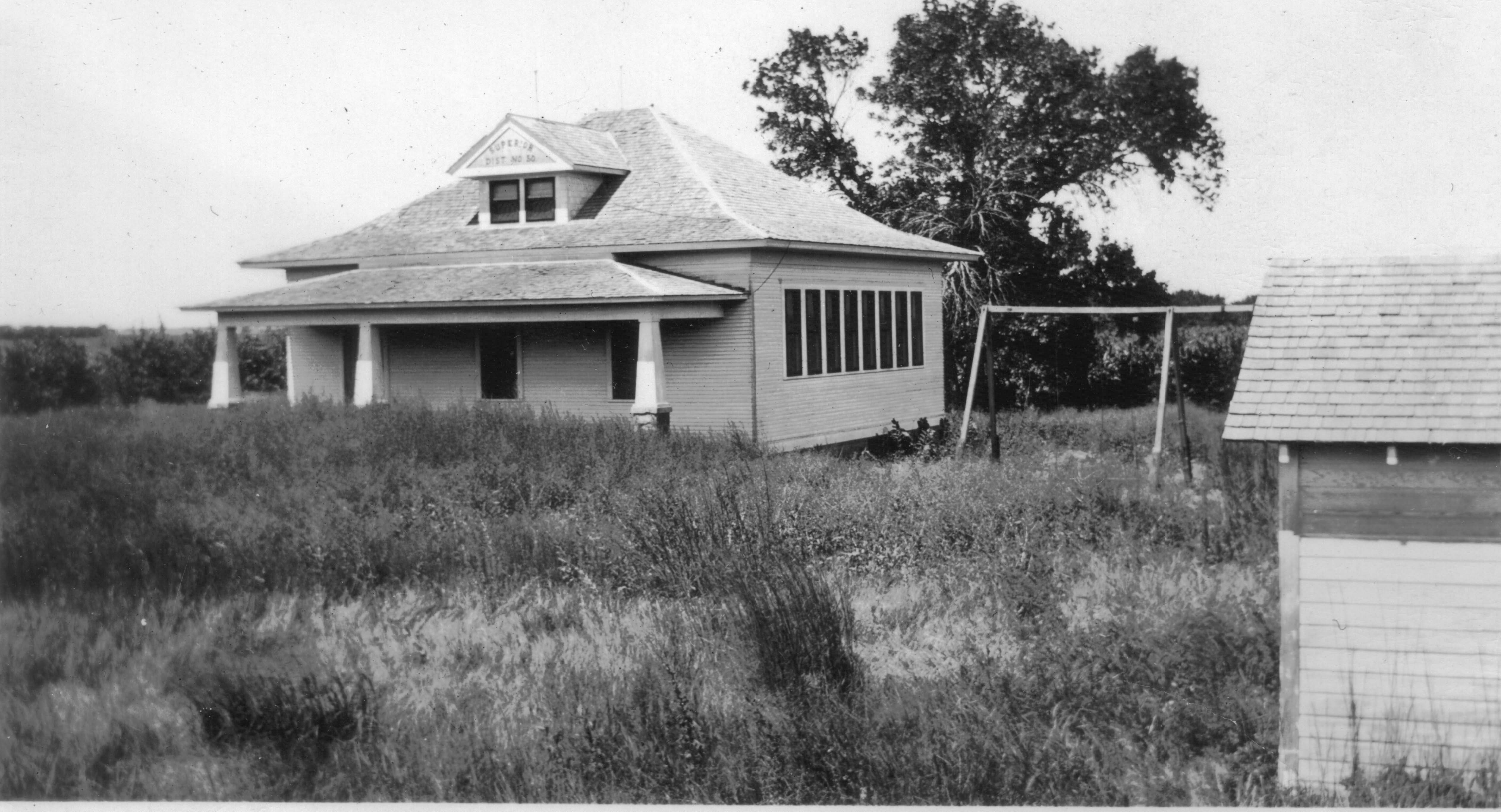
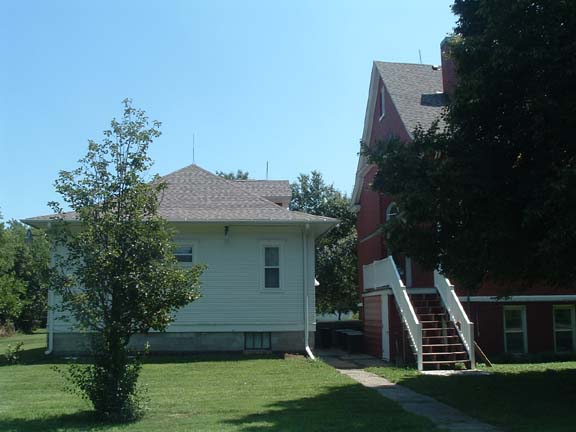
-Dalakarl
..............................
One Mile North
Our first connection with Stromsburg involved the road one mile south, where the Morrill homestead was located. That was where Elisabeth Carlson Greenwall worked with her sister Emma Carlson Forslund, and where she married grandpa John in 1901.
But since returning to Stromsburg in 1911 we have found the road one mile north of town to hold a lot of family history as well. Perhaps it was reading the "In Days of the Past" section of a 1936 paper that prompted these thoughts. There it was recalled that Lillie Forslund and Hartwig Flodman were married in 1912 in a farmhouse along that road, in the same house and standing in the same spot as Eric and Emma had tied the knot twenty-two years before. That former Lars Engdahl place is gone now, but the Forslunds farmed there for a time while caring for the elderly Engdahls.

Next we learned that Emma's cousin, Claus Carlson, farmed a place about a mile west of there. His grandson now lives in Rockford, Illinois, and has provided us with reminiscences of his father's childhood there including attending school district #50 of which we wrote recently. Claus' brother Eric was later a partner in the Forslund Grocery. The family was together often, many times in the square white house at 10th and Main which still stands.
Next we found an ancestor of Barb Cotter's lived at the place one mile north at the corner of the highway. In Sweden he was known as Anders Persson, living on a farm called "Bobak." In America, now known as Andrew Peterson, he gave the same name to his new place. "Bobak" may mean something like "the back place." At any rate, he was now referred to as "Andy Bobaken" in typical Swedish style.
Today no evidence of these many places remains, but a new place has appeared, occupied by the Ryan Petersons. It, too, has special interest since son Preston is a royal attendant for the 1915 Stromsburg parade float! All just one mile north.
-Dalakarl
........................................
Does Time Really Fly?
"Have you ever observed that time seems to be going by faster as you get older?" This was the opening line of an article entitled "Why half of the life you experience is over by age 7." I wonder if that article might have caught your eye, too? Most would agree to the first line, but that second one calls for a little explanation. The writer goes on to say that when you're one year old, that year is literally forever to you but as you grow older one year becomes a smaller and smaller fraction of your total life.
To test the theory with numbers, at age five a 24-day wait for Christmas to come seems the same as a whole year to a 54-year-old. That holds up pretty well in my experience. Another contrast is in the duration of summer vacations. Another student of this suggests that summer vacation from school for a teenager seems as long as a whole year to one who is 76.
So, with this in mind, half of your "perceived life" is reached at age 7! And since nobody remembers anything from the first couple of years, that, too, must be taken into account. But here is the good news about this theory:
The time we spend with our grandchildren seems brief to us, but much longer to them. Does that account for the reason grandparents have such a large impact on our lives? It makes me very glad to think that might be the case, and why this theory has a special appeal.
-Dalakarl
.....................................
Only 29 years ago
A good source of material for these columns comes from friends and neighbors that pass along things like this newspaper clipping from 1986. In it, a reporter named Mulligan demonstrated open-minded inclusiveness by writing a piece about Stromsburg Swedes, in a paper called the Tribune/News. Three immigrants to Stromsburg were interviewed.
Ellen Peterson was visited in her room at Covenant Home, and recalled seeing the statue of liberty from a snowy porthole in the shipboard cabin she and four other Swedish girls shared. They hurried up to the cold and windy deck for a better view and were a bit disappointed that the promised land of America seemed about as frigid as old Sweden.
Hannah Carlson was delighted with her newly adopted country. Her observation was one often heard; that in America the men helped with milking the cows, a job strictly assigned to women in the old country. She did demonstrate her skill at that to her American cousins however, by milking nine cows in a row. If you have a chance to watch the video she recorded at the library, you might be surprised as I was to learn that one of the things she missed most about Sweden was the outdoor dances on summer evenings.
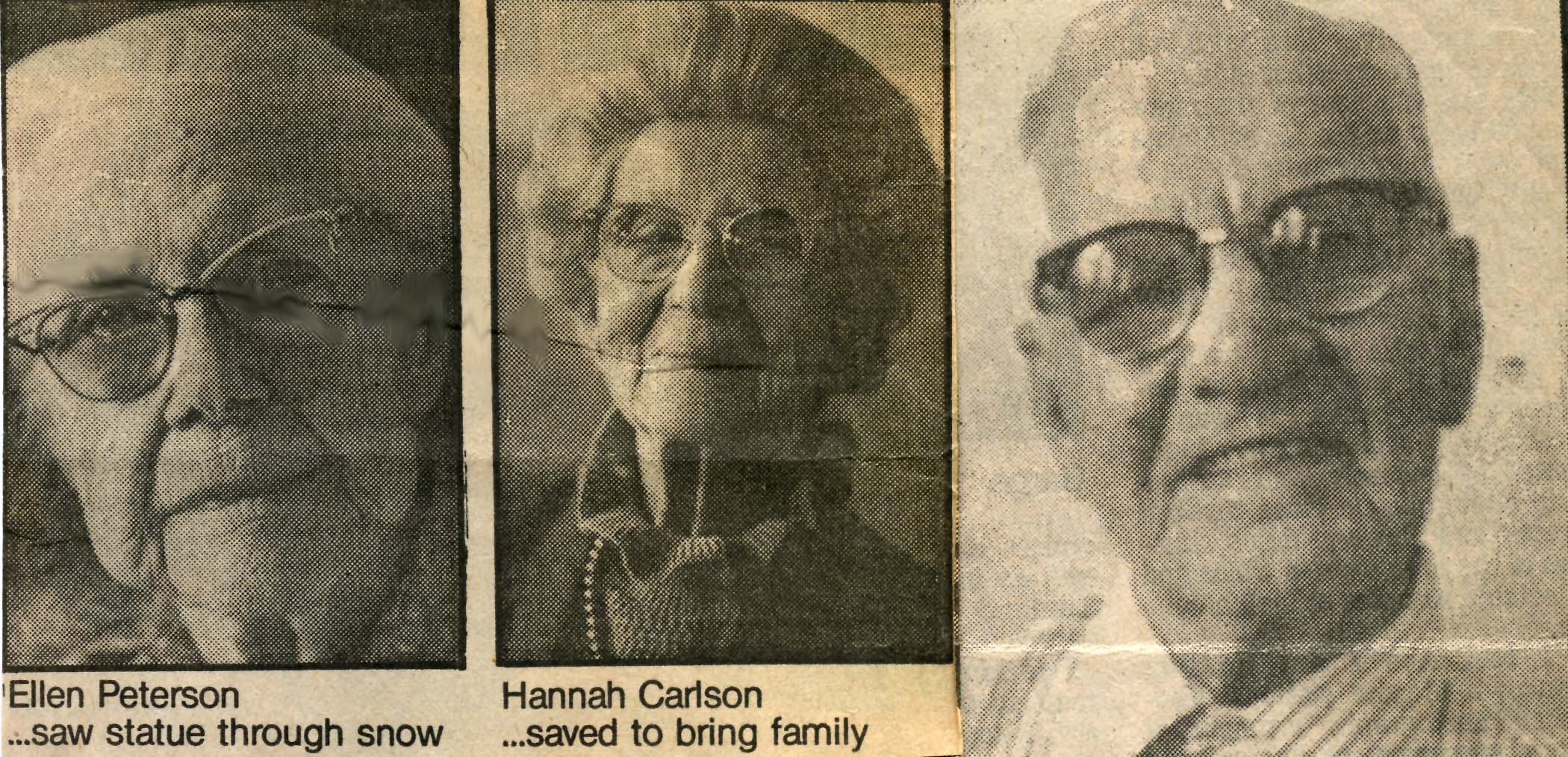
The third was Gust Granberg (on the right). What it must have been like for a 17-year-old to be shipped a thousand miles to Kansas with an address attached to his jacket, not knowing a word of the language, is hard to imagine. Through it all, Gust persevered as did so many others, and found a better life. In recent days I have been reading about his trip back to the homeland in 1936.
We can feel privileged to have known these folks, who in a sense were pioneers. One of the things I miss most about their generation is that distinctive Swedish accent in their speech. Each of these three had it, and it was unforgettable.
-Dalakarl
..................................
News from Arborville
My friend Donna from the Covenant Activities Department and I have known each other for a long time, but she surprised me with a bit of information never before heard. She once lived in a house that had previously been the Arborville Methodist church!
Arborville was a budding village south of Polk that fell victim to the whims of railroad planners when they bypassed it to the north, forming the towns of Polk and Hordville instead. Most of Arborville moved up to Polk. Similar fates befell such places as Swede Home and Stark when bypassed by the railroad. The Methodist church was not moved to Polk, though the members probably migrated to the Methodist church there. Instead it was moved to the road north and converted into a six bedroom home.
Most of us think of the Congregational church still standing at the Arborville site, the one served by Rev. Lester "Andy" Anderson for some time. That there was also a Methodist church there came as quite a surprise. But Donna had yet another eye-opener for me. There was also a Baptist church in Arborville! That building came to serve as the community hall.
A resident familiar with the area volunteered that at its peak, Arborville could boast a population of a thousand! Approximately half the residents and a considerable number of buildings and businesses moved up to Polk. One can only wonder what might have become of Arborville if circumstances had been different.
-Dalakarl
............................
The Railroad Engine House
Many times I have wished for a picture of the engine house down at the railyards. Since both the Burlington and Union Pacific branches terminated here, it was helpful to provide shelter overnight for the engines before making their return trips. Crewmen also lived in some of those small houses nearby. There was one map which gave its general location, but no picture.
Till now, that is. Thanks to the social media page "Historic Stromsburg" there are actually two birdseye views showing the engine house as well as the flour mill and many other details. I admit it took me a while to figure out that when a sign "plus 10" or "plus 15" appears on a picture, you can access many more shots than first appear.
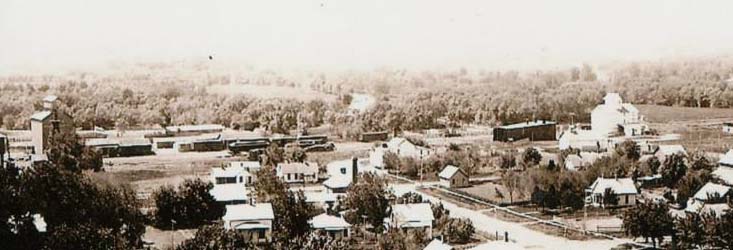
One can spend a lot of time studying pictures like this, and one question that arises is how the cameraman achieved such a high viewpoint in the first place. Remember, no drones in those days. A balloon might be a possibility but here is another theory.
In column 143, we quoted jeweler J.A. Anderson: "His story about the old hotel, called at one time the Ryder House, a block east of the southeast corner of the square, is very interesting. His father had constructed the original building as a wagon-building shop in 1884. Later a second story was added with the unusual feature of having a windmill on the roof for the purpose of driving a feed mill. 'Sometimes the mill would not run because the wind did not blow, then my father had a basement dug under the mill where he kept a team of mules to run the mill. I was the lucky one to take care of the mules.' No doubt this experience made a deep impression on young Anderson."
The birdseye views would have come from a vantage point just about where the city garage is now, the site of the old Ryder House. The windmill might just have provided the platform. Not many houses are recognizable: 208 E 2nd. for one and the Buckley House for another.
-Dalakarl
..................................
Not all news is good news
But as suggested above, not all news is good news. That summer the two grocers decided to celebrate their birthdays, Forslund's seventieth and Carlson's forty-first, by having free refreshments and special prices on foods including a free banana with each purchase. A later report stated that six hundred people visited the store that day, and over four hundred took advantage of the coffee "and" as well.
It was a Saturday, and Forslund was up early to go to the store to make ready for the festivities. Then came the dreadful phone call: his beloved Emma had died.
We know how small towns are. Those many guests at the grocery store that day would have been grieving together with the Forslunds and Carlsons, a kind of visitation. The birthdays and business celebration would have been forgotten. It must have been a somber day for Stromsburg.
Two generations later we know we have been protected from the knowledge of such sad events by the sheltering instincts of grandparents and parents who simply did not tell us about them. It is the preservation of such things as old newspapers which allows us insights into those sad bits of news and also allows us to grieve along with our ancestors even now.
-Dalakarl
..................................
Another Professor in the News
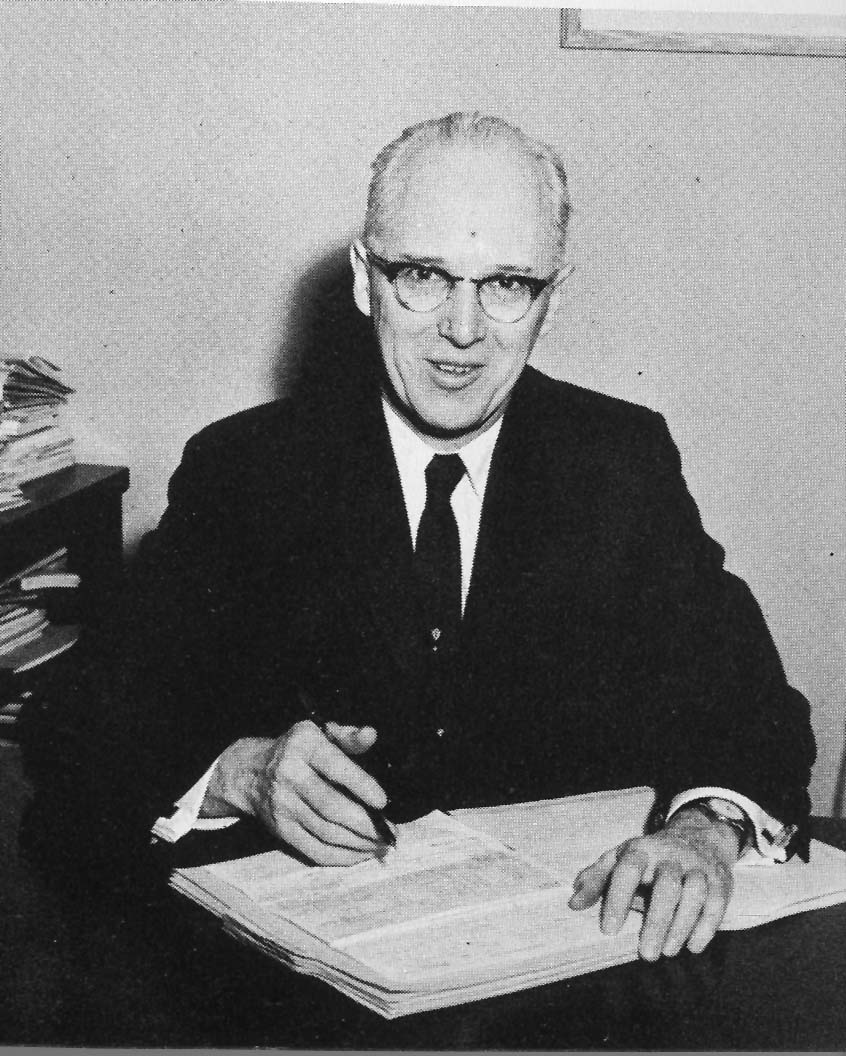
Could this be the same Oscar Olson who was at North Park when I went there in 1961? The same one who was father to my schoolmates Chuck and Ruth, who we saw this summer at our fiftieth reunion? Sure enough, it turns out that unbeknownst to me, Oscar Olson had a Stromsburg connection. I quickly sent copies of these announcements to my classmates, who confirmed that this was indeed their dad.
Hoping that more news about this wedding would surface, it was not long before that, too, came to fruition with a full column describing the wedding. I am eager to send this to the family as well, along with a picture of the Banta house which survives in beautifully restored condition thanks to Mr. Stenger.
The report is in great detail, as wedding writeups were in those days, including out-of-town guests. One of these was a colleague of Oscar's, E. Gustav Johnson. "E. Gust" as we knew him was a founder of the Swedish-American Historical Society of Illlinois and the archivist at North Park. He was musically inclined as was Oscar, and his name appears as the translator of several Swedish hymns familiar to us.
The most well-known of these we heard sung by the grandsons of Dorothy Youngquist at her graveside service recently: "O Mighty God, When I Behold the Wonder" (How Great Thou Art). Yes, the translator of this hymn was in Stromsburg in '36, at Oscar and Helen's wedding!
-Dalakarl
..............................
When Dreams Come True
The line from a well-known musical goes something like this: "If you don't have a dream, how are you going to have a dream come true?" When imagining how an archive of preserved books and documents from the immigrant generation could take shape, it might look something like the following story.
Mr. and Mrs. (nee Nelson) Wiggle of Lincoln called the local library with a question. She (Mitzi) had inherited a large collection of family books and documents going back into the 1800's from the province of Skåne, Sweden. She could find no one interested in preserving these books and knowing that Stromsburg is the "Swede Capital," asked if there might be someone here who would help her?
To quote another tag line, this time from an old TV program, "I love it when a plan comes together!" It doesn't happen often, but thanks to the library putting us in touch with one another, we have added two large boxes of books and a large typewritten family history to our embryonic archive. Mrs. Wiggle's family included some language scholars, one of whom wrote a Japanese-English dictionary which is in use in revised form to this day. The family included missionaries to the far east.
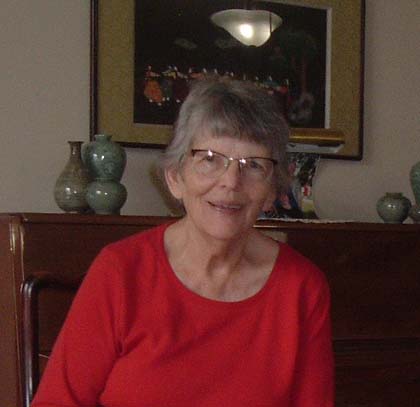
Unique to this collection is its range. Beginning with material from the Swedish State Church, through books from the revival era, and to a little-known tributary of Swedish-American piety, the Swedish Seventh-day Adventists, it traces a path that stretches the imagination.
The first book I have examined is relatively recent, 1983, and is a look back on the first part of the 1900's when poverty and overpopulation forced Sweden into social reforms. By then much of the population had abandoned their homeland for America. The pictures and stories in this book call to mind very similar ones in our own families: parents and numerous children standing before modest cottages with even some items of furniture and farm animals included!
These are things that need to be preserved. Thanks to the Nelsons and the library for making possible another step toward that goal.
-Dalakarl
..............................
A Stained Glass Window Story
When a question comes to us about a Polk county pioneer, especially one of the church founders, it is always a pleasure to respond. When that question comes from a teen-ager with a passion for genealogy it is doubly delightful. That has been the case with Mr. Änders Swanson of North Platte whose ancestors are from here. He found his best source in Jeri Barber, who provided him with a complete record of the farm property acquired by John Swanson as well as a copy of his will with all of the family information included therein.
What Änders supplied to us were some wonderful family photos of the insides and outsides of houses with cars from the period. It was descendents of Swanson who built the miniature auto shown in the history books; the one which actually could be started and run. They also built full-sized autos for local customers. He pointed out a detail in two of the pictures which tied an inside view with one from the outside. It was an ornate stained glass panel at the top of a front room window with a distinctive pattern.
Earlier another descendant of the Swanson clan had pointed out that their farm was on highway 92 just east of the "big corner" where 92 and 81 join. It is most easily identified by the two white concrete posts flanking the driveway. A glance at the house on that place suggested it might be similar to one of the pictures from Änders. For those who identify that place as a Walgreen farm, remember that Norma Walgreen was one of the Swansons...
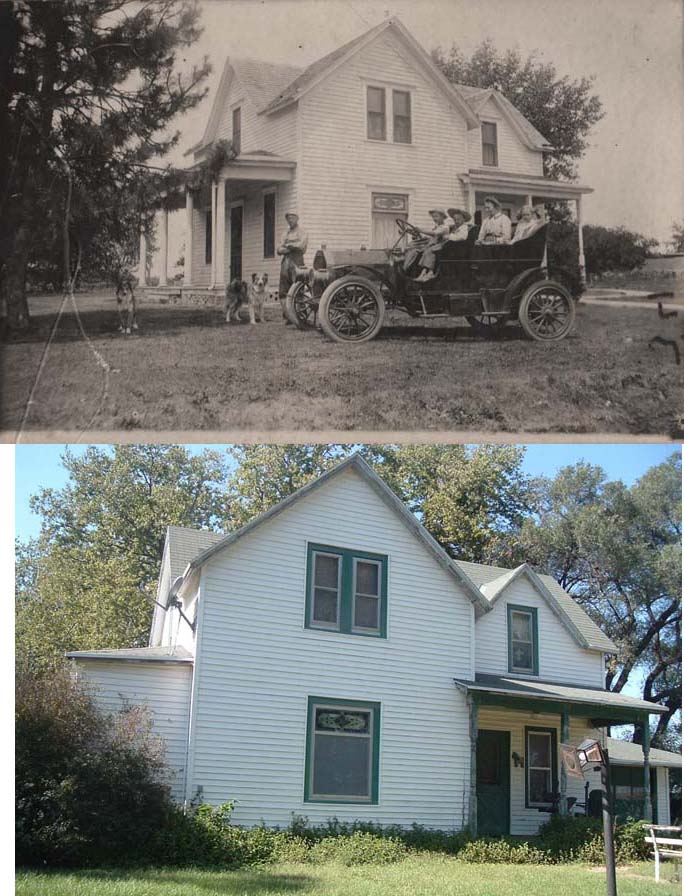
But was that window there? Finally yesterday I ventured past the trees which obscured the view from the road and, finding nobody there, took a photo of the indisputable proof: the window is still there! Next comes the email to Änders showing that we have found the house with the window he showed us, and a picture of Mrs. John Swanson from our church's fortieth anniversary book.
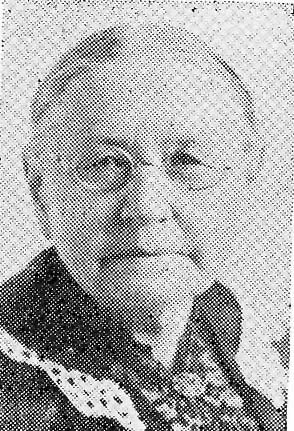
At that time she was one of three surviving charter members and had served the whole time as chairperson of the ladies aid. It was her husband who wrote to his friend, professor Charles Anderson in Illinois, requesting a pastor for the Mission church. That pastor was C.A. Falk. Given her prominent role in that congregation, it would not be surprising to think of her looking over John's shoulder as he penned that letter.
-Dalakarl
......................................
Gladys Strom's books return
"Rev. and Mrs. Carl Olsson and their three children spent Christmas day in Stromsburg, visiting Mrs. Olsson's grandmother, Mrs. Charlotte Ekstrand, and other members of the family. Mrs. Olsson (was) Miss Gladys Strom when employed in the Headlight office for five years, and while here, paid a brief visit to our home, in company with her husband and uncle Enoch Ekstrand. Rev. Olsson has been located in Portland for the past few years but has been transferred to a larger church in Chicago, on the south side. Rev. Olsson is one of the outstanding ministers in the Baptist denomination."
A popular radio newsman, one that all seniors have heard, used to feature a segment ending with "now you know...the rest of the story." The piece above from the last Headlight issue of 1936 provides just such an example. A much earlier column of ours made reference to a collection of books obtained in Omaha about the Swedish Baptists. These books were marked as once being the property of a "Gladys E. Olsson" or a "Carl A. Olsson." There was also material from the prominent Emerald Avenue Swedish Baptist church on the south side of Chicago in that collection.
Apparently these items came on the used book market from the Olssons' estate and became a rich resource for us. What we did not know till reading the 1936 news item above, was that Mrs. Olsson, nee Strom, was from Stromsburg and a relative of the Ekstrands. What is the likelihood that this collection would return to Gladys's home town, or that so many years later an old news item would tell "the rest of the story?"
-Dalakarl
.................................